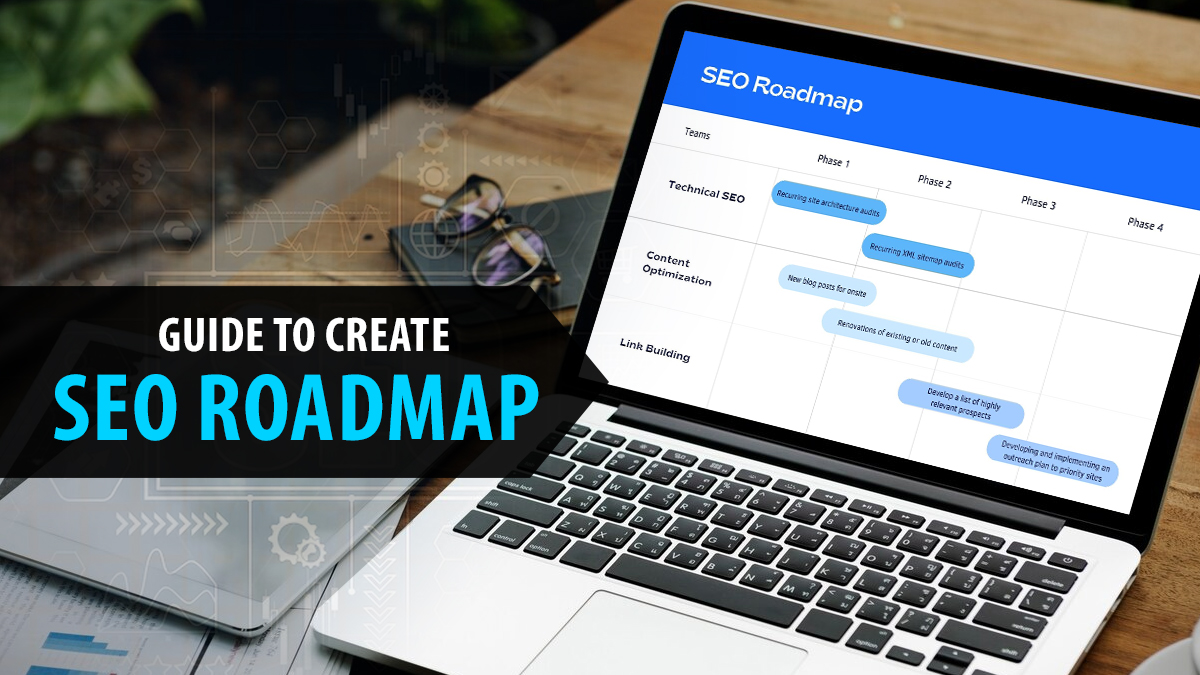After establishing a strong SEO foundation, the next critical step is developing a strategic plan. This plan will act as a framework for tracking goals, addressing challenges, and optimizing your SEO efforts effectively.
Enter the SEO roadmap, an essential tool in your digital marketing arsenal.
In this comprehensive post, we will dive into the details on how to create SEO roadmap, examining its crucial elements for success. Following this, we will provide user-friendly templates to streamline the creation of your customized plan. Together, let’s chart a course toward SEO success.
What Is an SEO Roadmap?
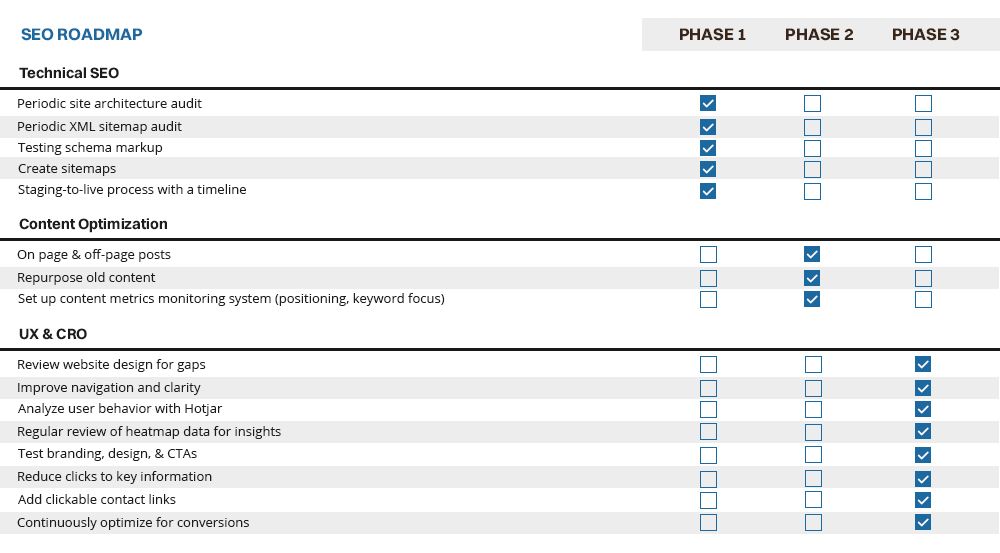
An SEO roadmap is a strategic guide that methodically outlines essential SEO activities for project success. It is more than just a document; it’s a deliverable that clearly and comprehensively presents your planned activities to clients. SEO service providers place immense importance on creating an SEO roadmap, considering it a foundational element for achieving long-term digital marketing success.
These roadmaps not only set a timeline but also provide insights into the methodology for addressing errors and tackling decision-making challenges encountered during the project. Their adaptability allows for adjustments in response to the project’s complexity and ongoing implementation. The advantages of such a document are manifold. When carefully crafted, these roadmaps:
- Help clients, vendors, and team members clearly understand the overall strategy.
- Offer valuable insights on strategically scaling your efforts.
- Ensure continuity and transparency of the strategy, especially during personnel changes.
However, the success of these strategies in maintaining project continuity hinges on their precision. Let’s delve into methods to improve and refine your SEO roadmap for the best possible results.
What Should You Include in Your SEO Roadmap?
Each SEO plan is unique, and tailored to meet the specific needs of the project. The objective is to simplify the approach while ensuring it is easily understandable. The services you offer significantly influence your marketing plan. Here are key SEO tasks to consider incorporating:
- Website Essentials: Focus on ensuring your website’s user interface is friendly, navigation is simple, and design is responsive.
- Technical SEO: Address technical aspects affecting search engine visibility, like website structure optimization, crawlability, and site speed.
- Content Optimization (including Content Audit Results): Align your content with SEO best practices. Use content audits to evaluate and improve existing material.
- UX & Conversion Rate Optimization: Improve user experience for better navigation and engagement, and optimize conversion rates by analyzing user behavior.
- Link Building: Develop strategies for acquiring quality backlinks to enhance credibility and search engine ranking.
- Local SEO: If applicable, optimize for local search, manage online reviews, and implement local SEO strategies.
- SEO Benchmarking: Establish benchmarks and key performance indicators to monitor SEO activities.
- Quick Wins: Implement strategies for immediate improvements in rankings or user engagement.
- Topic and Keyword Research: Conduct thorough research to identify key subjects and keywords, creating content focused on these areas.
These recommendations should be customized to fit your specific needs. Let’s explore these elements in more detail.
Website Essentials
Adhering to fundamental optimization guidelines is crucial for any website. Neglecting these can hinder your site’s ranking potential.
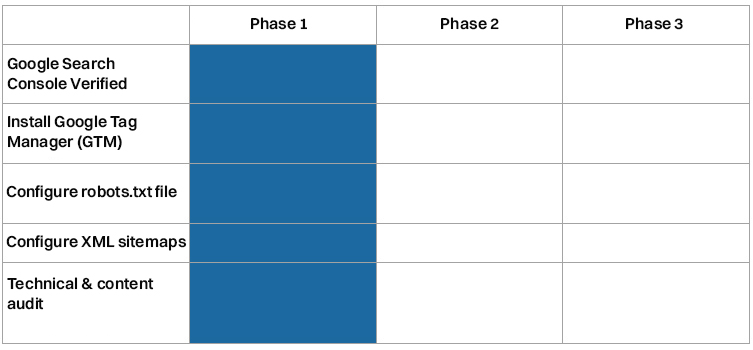
Key practices include:
- Verification via Google Search Console: The first and crucial step is verifying your website through Google Search Console. This platform provides a direct line of communication with Google, allowing you to address site issues and boost its visibility.
- Google Tag Manager implementation: Using Google Tag Manager streamlines the management and deployment of various tracking codes on your website. It improves control and organization by simplifying the process and offering a unified platform.
- Robots.txt file configuration: Proper configuration of your robots.txt file is essential for directing how search engines crawl and index your site. This ensures that search engine bots navigate your website efficiently.
- Creating and setting up site maps: Developing and configuring site maps are vital for aiding search engines in understanding your website’s structure, which enhances indexing and, in turn, search engine visibility.
- Conducting comprehensive audits: Regular SEO audits are crucial for identifying both technical and content-related areas that require attention. These audits act as diagnostic tools, pinpointing areas for improvement and helping maintain your site’s overall health.
These tasks are fundamental, particularly for new websites. However, the focus may shift slightly with well-established sites, where beginning with in-depth audits is often the best approach.
Audits typically uncover hidden issues, highlighting the importance of implementing technological solutions in digital projects. By addressing these issues, you not only improve your site’s performance but also contribute to its enduring success in a competitive digital environment.
Technical SEO
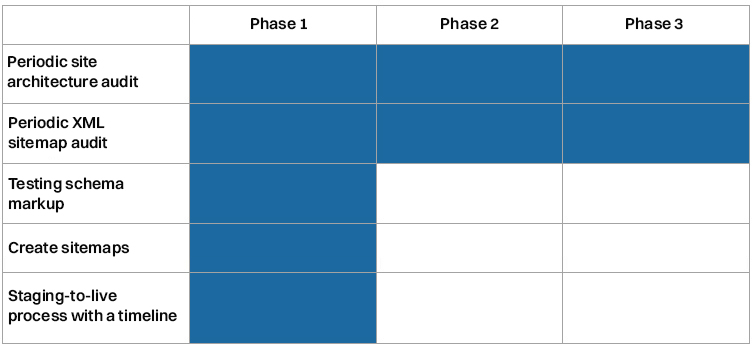
Incorporating a range of technical checks and tests from the onset of your project is crucial. Technical issues with your site can significantly hinder progress towards achieving your SEO goals. Addressing these concerns promptly is therefore essential.
Your plan should include regular follow-up audits to check if any changes made to the site have led to new errors. This involves devising a clear strategy for future audits and establishing a systematic method to identify, resolve, and rectify any issues that may emerge. Such a proactive approach not only preserves the integrity of your website but also ensures that your SEO objectives are consistently met.
Also Read: The 15 Best Technical SEO Tools Every Webmaster Should Know!
Content Optimization (Including Content Audit Results)
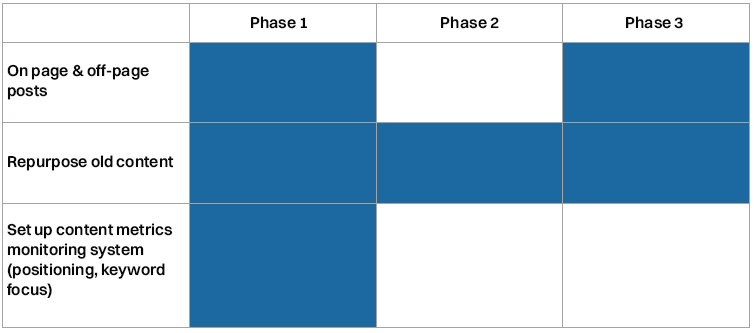
Your website’s content, encompassing everything from titles and body paragraphs to anchor texts, shapes the user experience through effective messaging.
Roadmaps are vital in guiding the content deployment process, providing a clear view of the topics covered and the production pace. This systematic method helps in controlling your content strategy.
As you scale your content development, meticulous planning becomes increasingly important. The growing volume of content necessitates a well-structured plan to keep the project on course.
While content is a key aspect of SEO strategies, it’s not a panacea. Poor website design can undermine the impact of even the best content. In such cases, prioritizing User Experience (UX) is crucial. Your plan should reflect this focus, ensuring a balanced approach to both content management and UX.
UX and Conversion Rate Optimization
User experience (UX) is a key metric in assessing how well your website serves its visitors. High-quality UX is characterized not just by visual appeal, but also by the absence of noticeable flaws like broken images, swift loading times, and easy navigation. In contrast, websites with subpar user experience often suffer from issues like broken images, incompatibility with various browsers or devices, and confusing navigation.
Recognizing the importance of UX is essential. While Google might not fully grasp the visual elements as perceived by users, it can detect when visitors quickly leave a search result. This indicates a direct link between user satisfaction and search engine rankings.
Despite Google’s sophisticated algorithms, it ultimately depends on human searchers, emphasizing the critical need to prioritize an exceptional user experience.
Effective marketing strategies should include the following steps to align your online presence with these UX principles:
- Design Audit: Perform an exhaustive audit of your website, carefully identifying any broken or poorly executed elements that could detract from the user experience.
- Navigation Review: Examine and streamline your site’s navigation to improve ease of use, helping visitors quickly find what they need.
- User Behavior Analysis: Utilize tools like Hotjar to create heat maps that reveal user behavior on your site, offering valuable insights into how visitors interact with your content.
- Iterative UX Improvement: Develop a process for reviewing and applying insights from heatmaps and other analytics. This ongoing approach ensures constant enhancements to the UX, aligning your website more closely with user expectations and preferences.
Conversion Rate Optimization (CRO) involves identifying and addressing any hindrances in your sales funnel. The aim is to ensure that every element on your webpage effectively contributes to achieving your conversion goals.
To achieve this, you need to complete the following tasks:
- Split Testing: Test various branding elements, designs, and calls-to-action (CTAs) to see what resonates most effectively with your audience.
- Minimize Clicks: Simplify the user journey by reducing the number of clicks needed to access forms or locate commonly requested information. This not only improves user experience but also increases conversion rates.
- Clickable Contact Information: Make sure that contact details like addresses and phone numbers are clickable, enabling quick and straightforward interactions and streamlining the path to conversion.
- Regular Review: Regularly analyze and apply findings from conversion data. This ongoing process ensures that your optimization efforts are up-to-date and in line with evolving user behaviors.
Integrating these activities into your comprehensive SEO strategy with a focus on enhancing user experience is crucial. By doing this, you prioritize these improvements, ensuring they are effectively incorporated at the outset of your content initiatives. This approach ensures that upgrades to the user experience are a core part of your overall digital strategy, rather than an add-on.
Link Building

Link building, the practice of establishing links from other websites to your own, is key to enhancing your site’s visibility and authority. The quality and relevance of these links significantly influence your Domain Authority (DA), a metric by Moz that assesses the strength of your domain.
Domain Authority attempts to unravel Google’s complex ranking algorithm. Moz uses this metric to assign scores to websites based on various factors, with higher DA scores often leading to improved search engine rankings. A low DA can hinder your site’s ability to climb the Search Engine Results Pages (SERPs) or achieve effective rankings for certain keywords.
A methodical approach to link building is essential for its success. Instead of rapidly accumulating a large number of links, a strategic plan involves gradually acquiring new, high-quality links over time. This approach encourages the natural and sustainable growth of your site’s authority and performance in search engines.
In conclusion, the essence of effective link development lies in the quality and relevance of the links you establish, not just their quantity. A well-executed link-building strategy, underpinned by a solid understanding of Domain Authority, is vital for achieving long-term success in search engine rankings.
Local SEO
Local SEO focuses on optimizing search strategies for specific geographic locations, differentiating from global search rankings. It aims to attract users searching within a local or regional context.
A key goal in local SEO is to feature in the “Snack Pack,” which is a group of prominent results in local searches. For instance, if someone in Dallas searches for “organic grocery stores,” the Snack Pack would highlight the top local organic food businesses in the Dallas area.
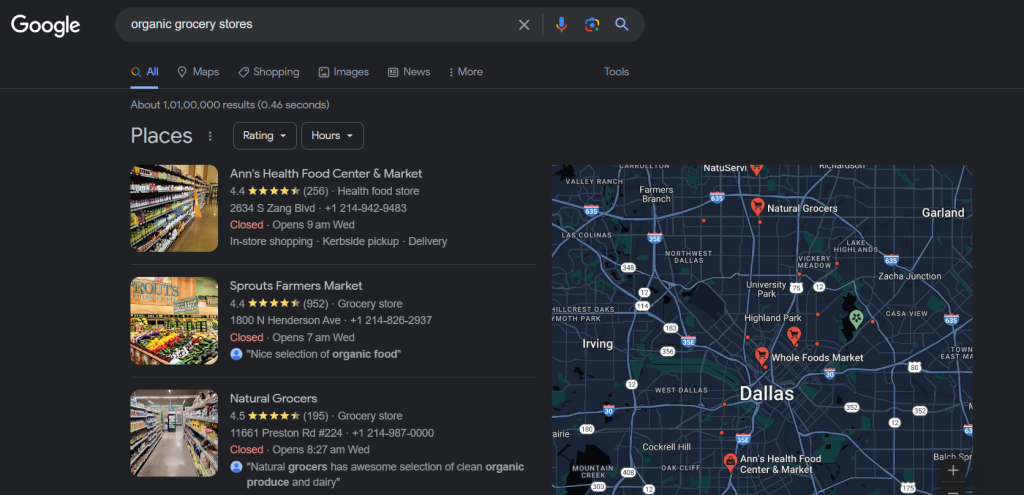
This optimization includes tactics that emphasize connections and content, establishing and emphasizing a business’s relevance to a local audience. However, if your website doesn’t serve a local market, the nuances of this strategy might not apply.
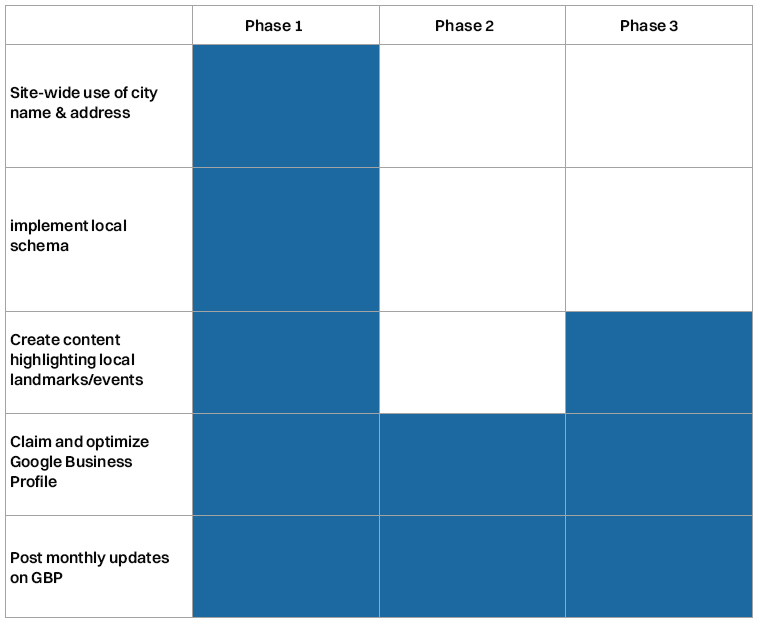
Like many SEO areas, local strategies require considerable time and effort. This highlights the importance of SEO benchmarking to effectively track and communicate the progress and impact of these methods to stakeholders.
Also Read: The Ultimate Local SEO Checklist for 2025: 12 Steps to Success
SEO Benchmarking
SEO benchmarking involves continuously monitoring established criteria throughout your project. It’s an ongoing process that should be integrated into all aspects of your work.
Transitioning to the business side of SEO, it’s crucial to show clients the tangible benefits of your methods. This calls for a detailed approach to track key indicators:
- Ranking Across Topics and Searches: Regularly evaluate how your content performs across different topics and queries to understand the effectiveness of your optimization.
- Traffic Trends Over Time: Monitor website traffic trends to assess how well your SEO strategies attract and retain visitors.
- Pace of New Link Development: Keep track of the rate at which new links are formed and others are organically acquired, as this affects your site’s authority.
- Time Spent on Site: Tracking how long visitors stay on your site is vital, as it reflects the value of your content and the level of user engagement.
When your efforts yield outstanding results, presenting them effectively is key. This might involve creating comprehensive reports or using visual representations to demonstrate the benefits to your client. Incorporating quick wins into your strategy can also underscore progress and success, bolstering your client’s confidence in your SEO expertise.
Quick Wins
Quick wins in SEO are tasks that yield immediate and predictable results, playing a vital role in the overall strategy of providing SEO services. While broader SEO strategies take time to show results, incorporating quick wins is essential for immediate impact.
Examples of quick wins include:
- Addressing Missing Basic Optimizations, such as Metadata: Ensuring that core elements, such as metadata, are optimized can have an instant impact. This involves organizing and structuring vital content on a webpage for optimal visibility to search engines.
- Resolving Site Errors Promptly: Timely identification and remediation of site faults, ranging from broken links to slow website loading times, contribute to quick wins. Addressing these issues promptly enhances the overall health and performance of the website.
- Ensuring Mobile Readiness: Implementing Recent Best Practices: Given the increasing popularity of mobile users, ensuring a website is mobile-ready is now a standard practice. Making essential mobile optimization adjustments can immediately enhance user experience and significantly impact search rankings.
Even with limited link profiles, acquiring a few new connections can yield significant improvements. However, remember that the lasting value of SEO lies in long-term results. SEO roadmaps are essential for strategically focusing on topics and keywords and building a strong, enduring online presence.
Topic and Keyword Research

Effective website focus requires thorough research into topics and keywords.
When discussing topics, it’s about the content covered by the website. For example, in promoting vehicle glass repair services, content should focus on key areas like auto glass repair costs, legal implications of damaged glass, and replacement timeframes.
Topic-related tasks include:
- Exploring topics associated with seed ideas.
- Reviewing the array of topics already present on the site.
- Introducing fresh content to rebalance the range of topics.
- Monitoring the SEO performance of the newly added topic pages.
Shifting to keyword research involves identifying specific search terms used by people. This step is crucial in realistically presenting topics. Tools like Ahrefs and SEMRush are invaluable for this research.
Keyword research tasks include:
- Conducting initial research to identify missed opportunities.
- Planning keyword updates for new or existing content.
- Experimenting with the implementation of keywords.
In summary, both topic and keyword research are fundamental in guiding a website’s direction and ensuring it resonates effectively with its target audience.
Creating a Roadmap: Use an SEO Roadmap Template for Guidance
There’s no one-size-fits-all approach to creating an SEO roadmap. Rapid and effective information transmission is key. For crafting visually appealing and practical SEO roadmaps, it’s advisable to start with a simple template.

Conclusion
Ultimately, developing a robust SEO roadmap is vital for any business aiming to thrive in the digital world. By diligently following the strategic steps outlined in this post, you can lay the foundation for enhanced online visibility, improved search engine rankings, and ultimately, greater success in reaching your audience. Remember, the essence lies in continuous monitoring, adapting to industry shifts, and a commitment to providing valuable content.
As you embark on your SEO journey, remain proactive and dedicated to refining your roadmap in response to evolving trends and user behaviors. With a well-structured SEO strategy, you’re not just navigating the complexities of the digital landscape, but also positioning your company for sustained growth and success.
FAQs
What are the essential components of an effective SEO roadmap?
A comprehensive SEO roadmap should include key elements such as keyword research, on-page optimization, technical SEO, content strategy, link building, and ongoing performance monitoring. Together, these components work to enhance your website’s SEO health.
How do I conduct keyword research for my SEO roadmap?
Start by using tools like Google Keyword Planner or SEMrush to identify relevant industry keywords. Consider factors like user intent, search volume, and competition level. Organize keywords into themes to guide your content creation and optimization efforts.
Are there any common pitfalls to avoid when creating an SEO roadmap?
Yes, common pitfalls include overlooking mobile optimization, ignoring user experience, over-optimizing content, and underestimating the importance of quality backlinks. Stay updated with industry best practices and adjust your roadmap accordingly to avoid these errors.
How often should I monitor and adjust my SEO roadmap?
Regularly review your website’s performance with tools like Google Analytics and Search Console. Assess the effectiveness of your SEO initiatives, track keyword rankings, and analyze user behavior. Update your roadmap to reflect changes in industry trends, algorithm updates, and your audience’s evolving needs.
